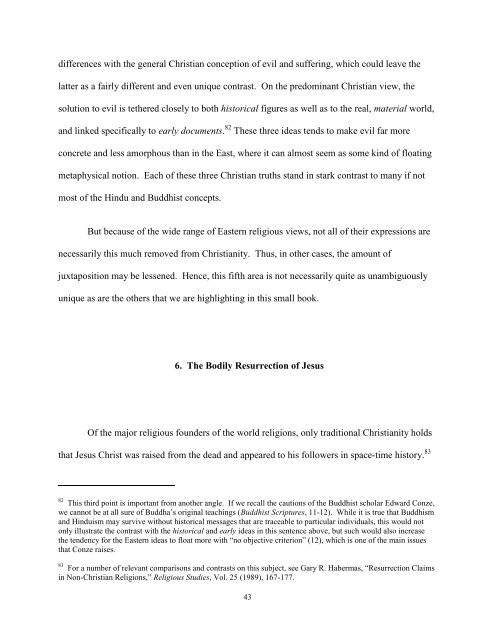Published by
299z7CN
299z7CN
Create successful ePaper yourself
Turn your PDF publications into a flip-book with our unique Google optimized e-Paper software.
differences with the general Christian conception of evil and suffering, which could leave the<br />
latter as a fairly different and even unique contrast. On the predominant Christian view, the<br />
solution to evil is tethered closely to both historical figures as well as to the real, material world,<br />
and linked specifically to early documents. 82 These three ideas tends to make evil far more<br />
concrete and less amorphous than in the East, where it can almost seem as some kind of floating<br />
metaphysical notion. Each of these three Christian truths stand in stark contrast to many if not<br />
most of the Hindu and Buddhist concepts.<br />
But because of the wide range of Eastern religious views, not all of their expressions are<br />
necessarily this much removed from Christianity. Thus, in other cases, the amount of<br />
juxtaposition may be lessened. Hence, this fifth area is not necessarily quite as unambiguously<br />
unique as are the others that we are highlighting in this small book.<br />
6. The Bodily Resurrection of Jesus<br />
Of the major religious founders of the world religions, only traditional Christianity holds<br />
that Jesus Christ was raised from the dead and appeared to his followers in space-time history. 83<br />
82 This third point is important from another angle. If we recall the cautions of the Buddhist scholar Edward Conze,<br />
we cannot be at all sure of Buddha’s original teachings (Buddhist Scriptures, 11-12). While it is true that Buddhism<br />
and Hinduism may survive without historical messages that are traceable to particular individuals, this would not<br />
only illustrate the contrast with the historical and early ideas in this sentence above, but such would also increase<br />
the tendency for the Eastern ideas to float more with “no objective criterion” (12), which is one of the main issues<br />
that Conze raises.<br />
83 For a number of relevant comparisons and contrasts on this subject, see Gary R. Habermas, “Resurrection Claims<br />
in Non-Christian Religions,” Religious Studies, Vol. 25 (1989), 167-177.<br />
43


